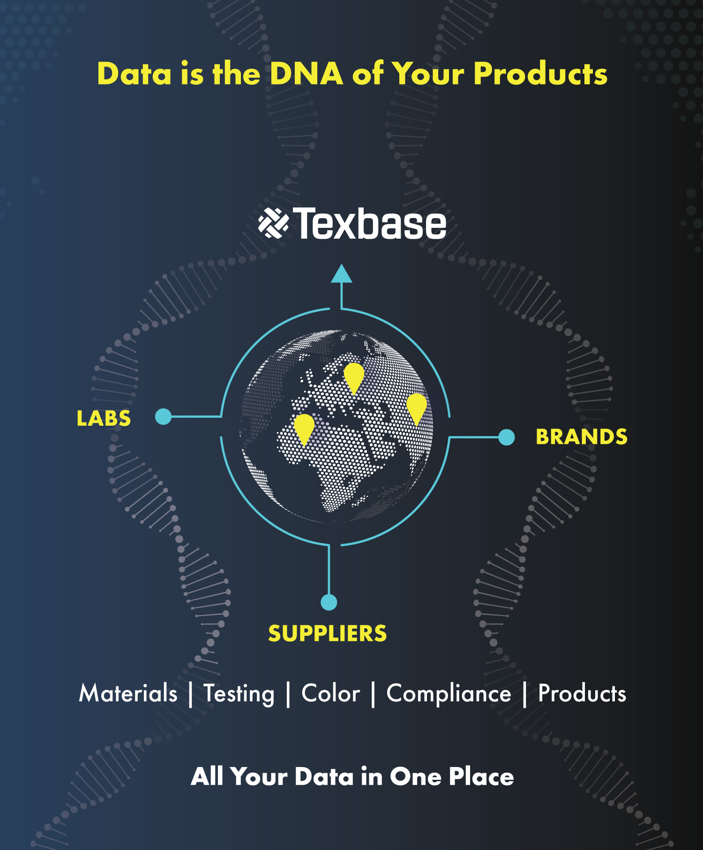Eliminating Data Gaps with Connected Supply Chains
Managing lab reports, supplier emails, and test data across too many systems? Watch how leading brands are fixing broken workflows and closing data gaps with connected supply chain tools.
Texbase delivers the digital supply chain of the future, collecting all your data no matter where it is generated and stores it all in one place.

It used to be that cost was the greatest factor in sourcing and selling products. No more. Now it’s all about the data.
Despite the most cost-efficient sourcing strategies, you can’t sell product these days if you don’t have the correct data to validate what it is, what it’s made of (and not made of), where it came from and before long, how to handle its end-of-life. To maintain cost efficient processes in developing, manufacturing and marketing products, supply chains must be digitally connected. That means no more re-typing data.
Our industry is highly fragmented which makes this challenge especially vexing. Texbase provides integrated solutions that seamlessly connect all members of a supply chain and delivers a proven framework where data flows efficiently and uninterrupted.
Eliminating Data Silos
Applications that store data but don’t digitally connect to upstream or downstream systems create data silos. Data silos reduce collaboration and transparency. They create barriers between teams and throughout supply chains. They decrease productivity and increase costs.
All companies have data silos that need to go away and never return. The first step is to identify them and then create a plan to merge them in a way that eliminates manual work, accelerates the flow of data and provides decision makers with access to relevant, timely and accurate information. Lastly, we must strive to not create new silos as eventually they’ll need to be torn down.
It's all about connecting the dots and removing barriers between systems. At Texbase we’re constantly working with clients to understand workflows and implement best practices to mesh internal teams and external stakeholders together, resulting in a comprehensive solution to the challenge of eliminating data silos.

Delegating Keystrokes
Often, we find ourselves having to manually move data from one place to another. Data should be entered once, captured at its source (the data provider) and then flow electronically to downstream data consumers. Doing so eliminates work, reduces cost and increases both data accuracy and personal productivity. All this results in an increase in creativity by not being enslaved to a keyboard. Just say no to re-typing data. If you find yourself entering data into one system that already exists in another, figure out how to eliminate that step and get the data to flow electronically.
Texbase Connect allows data providers and data consumers to interact online and in real time, capturing data at its source and storing it in one central location no matter where it originates in the supply chain.
Be Proactive, Not Reactive
Now more than ever, our industry needs to proactively define and validate the materials we need along with their source-streams. This must happen prior to adoption. It’s too costly and it carries too much risk to assume that someone downstream will figure it out. We shouldn’t be reverse-engineering supply chains. We should be proactively documenting supply chains along with all the required data to be compliant with regulations as we go through the processes of developing and producing product. Only then will we sufficiently eliminate risk and efficiently capture the validating data that’s necessary to meet the requirements of shipping product into a globally complex regulatory environment.
The goal of reducing the environmental cost of the products we make combined with both existing and upcoming regulatory requirements mandates that our supply chains must be digitally integrated. This is necessary to minimize the cost of compliance because products will always need to be cost competitive.
Supply chain data has never been more critical and our goal at Texbase is to keep innovating and evolving to meet the ever-expanding needs of our industry. By eliminating data silos, delegating keystrokes and being proactive in collecting data we’ll all have greater success in developing and producing product that is undoubtedly good for our people and our planet.
Managing lab reports, supplier emails, and test data across too many systems? Watch how leading brands are fixing broken workflows and closing data gaps with connected supply chain tools.
Learn how brands are organizing internal data to simplify compliance, improve collaboration, and prepare for evolving sustainability and regulatory requirements.
AAFA and Texbase explore the role of data and digital supply chains in meeting today’s sustainability and compliance demands.